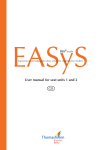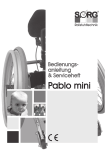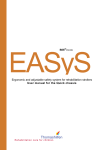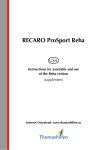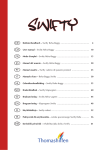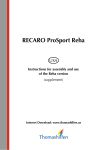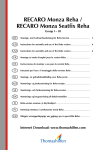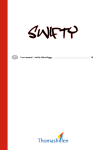Download User Manual Swifty Rehabilitation Buggy
Transcript
User Manual Swifty Rehabilitation Buggy Thomashilfen KinderReha Dear Swifty user, the Swifty rehabilitation buggy is a modern, high-quality medical product with an attractive design. We have made a point of integrating the ideas of parents who are familiar with the day-to-day handling of rehabilitation products and know what their children need from these products. Rehabilitation care products don’t have to look “medical”, and the Swifty also fulfils all the requirements of a good rehabilitation buggy: Seat depth and lower leg length are continuously adjustable while the high-quality materials and solidly-built seat ensure comfort and safe handling. The buggy is highlymanoeuvrable thanks to its lightweight construction and front swivel wheels. It can be quickly and easily folded up and packed into the boot of any car. Should you have any questions or encounter any problems, please contact either us directly or your specialist dealer. Our address: Thomashilfen für Behinderte GmbH & Co. Medico KG Walkmühlenstraße 1 D - 27432 Bremervörde phone: +49 (0) 4761 / 886-68 or -63 www.thomashilfen.com Contents page General safety information ......................................................................................... 4 Unfolding / folding up ................................................................................................ 5 Adjustment options: seat depth................................................................................... 6 Adjustment options: backrest...................................................................................... 6 Adjustment options: lower leg length.......................................................................... 6 Adjustment options: footrest ...................................................................................... 6 Parking brake function ................................................................................................ 6 H-belt......................................................................................................................... 7 Upholstery.................................................................................................................. 7 Transporting: Preparing............................................................................................... 8 Transporting: Securing ................................................................................................ 8 Transporting: Fitting the occupant restraint system ...................................................... 9 Cleaning and care instructions..................................................................................10 Technical specifications............................................................................................10 Guarantee conditions / CE- mark ..............................................................................11 3 Please observe the following safety instructions: è We recommend that you adjust the seat depth and lower leg length settings at least once every 3 months to suit your child’s growth. If necessary, seek assistance from your therapist / orthopaedic technician. è Your child should always be secured using the H-belt (standard equipment, see page 6) or a suitable alternative belt (available as an accessory). è You should check all controls and fastening screws every month. è After making adjustments, please remember to always re-tighten the screws and quick-release mechanisms (hip angle adjustment). è CAUTION: Wet tyres can adversely affect braking. When not in use or stopping for an extended period of time, secure the buggy using the foot brake to prevent it accidentally rolling away. è Please do not overload the Swifty rehabilitation buggy – refer to the specified maximum carrying capacity (see technical specifications, page 7). è Take advantage of reflective clothing to make you and your child visible to other road users, particularly in the dark. è Attaching shopping bags or other heavy items to the buggy increases the danger of it tipping over. Use the basket (available as an accessory) under the seat unit. è When using the buggy, please follow the recommendations in the instruction manual, especially when folding and unfolding. è Never leave your child unsupervised in the Swifty buggy. è Always make sure the parking brake is engaged when transferring your child into or out of the buggy. è To avoid the danger of choking, please keep plastic packing materials out of reach of your children. è The buggy is suitable for carrying one child only. TIP: More information on our rehabilitation buggies is available on our website at www.thomashilfen.com 4 Folding Unfolding Take hold of the buggy by the top side of the push bar and firmly pull it open (the sliders will lock audibly into place). Fold up the side plates of the seat to an upright position so that they lock securely into place. If the side plate’s locking pin does not lock into place automatically, give the head of the pin a slight turn. Tighten the lever on the back of the buggy. Set the height-adjustable push bar to the desired position using the buttons on the sides. Folding up (minimum size) Release the two side plates by pulling out the locking pins (to be found between the side plates and the frame, see fig. 1) and fold them down towards the middle of the seat. Release the quick-release mechanism on the back of the buggy. Pull up the sliders on the left and right bars and hold onto the safety bar mounted on the right. Use your upper body to push the push bar forwards and fold the buggy. TIP: To avoid the front wheels coming into contact with the rear axle when folding the buggy, you can give the steering forks on the front wheels a slight turn. Fig. 1 5 Adjustment options Seat depth Unscrew the front Allen screws (3 mm) on the seat surface, pull out the seat plate towards the front of the buggy and then re-tighten the Allen screws. TIP: To make setting the seat depth easier, grasp the front edge of the seat surface with one hand while pressing your other hand against the bottom centre of the backrest. Adjusting the backrest Release the quick-release mechanism on the back of the buggy (using the lever), set the desired hip angle using the lever on the back bar, then retighten the lever. Lower leg length Use the supplied Allen key (3 mm) to unscrew the Allen screws on the back of the left and right footrest sliders, slide the footrest along the bar to the desired position and then re-tighten the Allen screws. Footrest The footrest can be folded up for ease of transfer. Parking brake function To engage: press down the brake bar with your foot. To release: Place your foot beneath the brake bar and lift it up. 6 H-belt The Swifty rehabilitation buggy is supplied with a H-belt as standard. To adjust the length of the belts, unzip the padded section of the belts then set the length as required. 4 2 4 1 Opening the belt fastener To open the H-belt, hold down the red button (1), open the clip connector (2 and 3) and release the belt (childproof safety catch). 3 Adjusting the shoulder belt height Open the H-belt and release the shoulder belts from the pelvic belt (4). Detach and fold up the seat and back upholstery. Unscrew the screw fitting on the back plate using the Allen key (3 mm) and remove the belts. Undo the stitching on the seam of the desired height on the back upholstery. Pass the belts through the slit created and screw them tight to the back plate, then re-attach the seat and back upholstery. Removing the H-belt Open the belt fasteners completely, detach and fold up the seat and back upholstery. Unscrew the screw fittings on the back plate and the back of the seat area using the Allen key (3 mm) and remove the belts. Upholstery The upholstery can be quickly and easily removed. The material and the spacer fabric are high quality materials that are washable up to 40°C. The upholstery is fire-retardant. Please remember that even high-quality materials are subject to fading through longterm exposure to intense sunlight or repeated washing. 7 Transporting The Swifty can be folded for transport in the luggage area of a vehicle. The Swifty has been successfully impact tested against international standard ISO 7176/19 and ANSI/RESNA WC/Vol.1 – Section 19 6/22/99 Draft and may be used as a vehicle seat. IMPORTANT: When used as a vehicle seat the following instructions must be followed. Preparing the Swifty for transport: 1. Remove the following (if fitted); pommel, play tray, rain hood, sun canopy, grip rail, accessory bag and shopping basket contents. 2. Position the pushchair correctly in the vehicle over the floor track with the front of the pushchair facing towards the front of the vehicle (in the direction of travel). Put the brakes on. 3. Always ensure that the seat of the pushchair is in the most upright position (not reclined). Securing the Swifty in a Vehicle: 1. The pushchair must be secured in a vehicle using a 4-point tie down system that complies with either ISO 10542 Part 2, SAE 2249 or DIN 75078/2. (Such restraints are manufactured by Unwin Safety Systems and Q’Straint) Fig. 2 2. Vehicle operators and/or assistants should be fully trained in the use of wheelchair tiedown and occupant restraint systems. 3. The two front tie-downs must be attached left and right side to the steel ring located on each front castor mounting boss as shown in fig. 2. 4. The two rear tie-downs must be attached to the two securement points located on each side of the pushchair frame as shown in fig. 3. 8 Fig. 3 Fitting the occupant restraint system: 1. The pushchair passenger must be restrained using an approved vehicle safety belt. Thomashilfen recommends the use of either a split reel double inertia seat belt or a 3-point occupant restraint system. (Such restraints are manufactured by Unwin Safety Systems and Q’Straint) 2. Vehicle operators and/or assistants should be fully trained in the use of wheelchair tie-downs and occupant restraint systems. 3. The occupant lap belt must be routed low over the pelvis, avoiding contact with the abdomen of the passenger. Lap belt routing should be inside of the occupant side pad on both left and right sides of the pushchair, as shown in fig. 4. 4. The occupant lap belt should be tightened to make a snug fit without causing discomfort to the passenger. 5. If the pushchair is fitted with a harness, this should only be fastened after the occupant restraint system. 6. The shoulder belt of the occupant restraint system must be fitted to the side wall of the vehicle at a height that ensures the seat belt webbing lays in the middle of the occupants shoulder. Fig. 4 NOTE: To meet current regulations only a shoulder belt fitted to the side wall of the vehicle should be used to correctly restrain the occupant. 9 Cleaning and care instructions Hook and loop fasteners To ensure that the hook and loop fasteners continue to function efficiently, clean them occasionally using a brush. Always try to keep the fasteners closed during washing. Chassis The powder-coated aluminium frame can be cleaned using standard household cleaning products. Upholstery wash at 40°C do not use a hot iron do not dry-clean do not tumble-dry do not bleach Technical specifications Seat depth 24 - 30 cm / 9.4 - 11.8" Seat width 31 cm / 12.2" Back height 62 cm / 24.4" Lower leg length 16 - 33 cm / 6.3 - 13" Hip angle 90° to 115° Foot angle 90° Seat tilt +15° Footrest size (W x L) 31 x 18 cm / 12.2 x 7.1" Overall dimensions (W x H x L) 63 x 98 x 98 cm / 24.8 x 38.6 x 38.6" Dimensions when folded (W x H x L) 63 x 38 x 81 cm / 24.8 x 15 x 31.9" Push bar height 97 cm / 38.2" Wheel size, swivel wheels (front) 7,5" Wheel size (rear) 10" Carrying capacity 35 kg / 77.2 lb Weight 12.4 kg / 27.3 lb 10 Guarantee conditions / CE mark Thomashilfen is certified in accordance with the ISO standard DIN EN ISO 13485: 2003 and guarantees the quality of the products it supplies. Both material selection and processing meet the very highest of manufacturing standards. All parts are subjected to a final inspection. Thomashilfen offers you a guarantee of 3 years from the date of purchase for all chassis parts. This guarantee covers all claims affecting the functionality of the product. Damage due to improper use (e.g. overloading), and natural wear and tear are excluded. Swifty meets the requirements of the European EN 1888 standard and carries the CE mark. Enjoy using your Swifty rehabilitation buggy! Thomashilfen 11 Item code: 95538/GB, status: 09/2006, subject to technical alterations Member of the International Support Association for the Rehabilitation of Children and Youths e. V. Walkmühlenstraße 1 · D - 27432 Bremervörde · phone +49 (0) 4761 / 886-68 or -63 www.thomashilfen.com · [email protected]












